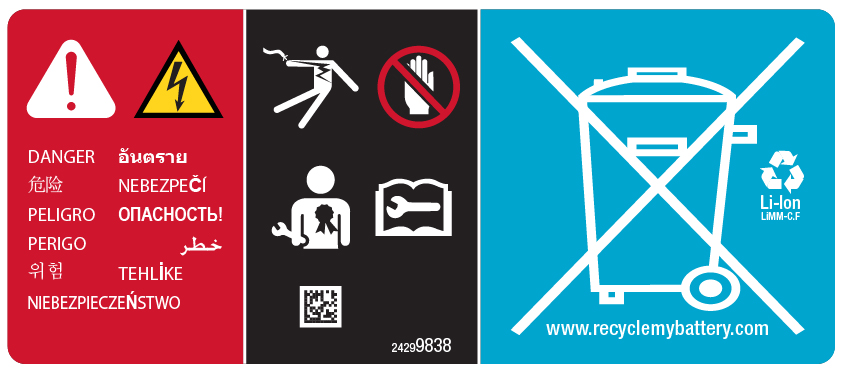General resources for Electric Vehicle battery storage, disabling, and removal
EV Battery Storage
GM hybrid and electric vehicles may contain an intermediate voltage (IV) or high voltage (HV) battery pack. Common battery types include nickel metal hydride (NiMH) and Lithium Ion (Li-ion).
Disable batteries prior to removal and storage. Comply with all high voltage (HV) safety precautions. Refer to Disabling & Dismantle page for additional safe removal information.
General Guidelines: IV/HV Battery Storage
Once the battery has been safely removed from the vehicle:
Assess the battery type, state of charge (SOC), container material/style, storage area ceiling height, material storage height, array of material (ex. shelf, bin box, palletized batteries, open rack, etc.), and aisle width.
To reduce the risk of fire and/or the amount of stored energy in the pack that can fuel/feed a fire:
- Verify coolant/antifreeze has been properly drained from the battery pack.
- Storing batteries at 30% SOC or less is recommended.
- Protect battery terminals (if required) from short circuits (non-conductive material).
- Store the battery in a building or under a shelter area so that:
- Batteries are kept dry
- Batteries are not exposed to high temperatures
- Protect batteries from damage (e.g. crush, drop or puncture)
- Sort and store batteries by type. Separate lead acid batteries, NiMH batteries, and Li-Ion batteries from each other (e.g., separate pallets or storage locations).
- Battery Type can be determined from the GM Battery label as shown below.
- Accumulate IV/HV batteries within quantity and time limits imposed by local regulations.
- Recyclers may have specific packaging requirements. Inquire in advance to avoid repacking/ restacking batteries.
Note: Fire suppression system options for battery storage areas vary and should be assessed against local regulations.
Battery Disposal and Battery Danger Label Reference Label(s):


Please check the battery label to verify the battery chemistry. Battery chemistry isn’t specific to a particular vehicle model. GM battery labels are developed in accordance with SAE J2984. Please, refer to SAE J2984 for further information on battery chemical identification.
If a battery is damaged (physical damage or leakage), consult the Safety Data Sheet (SDS) of the battery manufacturer or the Nickel Metal Hydride or Lithium Ion Battery Information Factsheets.
Note: Comply with all federal, state/provincial, and local laws and regulations related to management of Intermediate Voltage (IV)/High Voltage (HV) batteries. State and/or local laws can be more stringent than federal or national regulations.
Disabling and Removal
IDIS: INTERNATIONAL DISMANTLING INFORMATION SYSTEM
(available in select regions only)
IDIS is the advanced and comprehensive information system for pre-treatment and dismantling information for End-of-Life Vehicles (ELV). It contains safe handling information with focus on airbag deployment instructions, handling and treatment of high voltage batteries as well as gas vehicles. Additionally, it provides user friendly navigation to an extensive database with practical information on pre-treatment, dismantling of potentially recyclable parts and other elements mentioned in ELV regulations (e.g. mercury, lead, cadmium and chromium VI).

